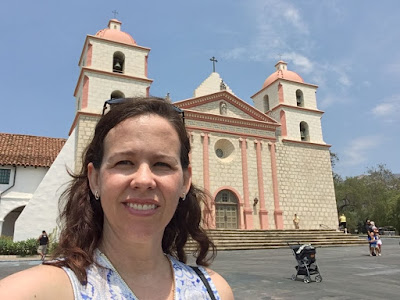We got to Santa Barbara a few months too late for the I Madonnari art festival, which was held at the end of May. Street painters create works of art in chalk on the Mission's entry plaza. Luckily the pastel chalk they use lasts a long time and Santa Barbara doesn't get much rain, so we were able to see the remnants of the artworks. I'm sure the colors are much more vivid when fresh.
After visiting the Mission, we drove up into the surrounding hills to have lunch at the Cold Spring Tavern. This used to be a stagecoach stop on the San Marcos Pass - the tavern building dates back to 1886. On weekends they have live music, and the bluegrass band that was playing when we were there (the Salt Martians) was really good.
On Sunday we took a ferry out to the Channel Islands National Park. It's one of the few US National Parks that you can't get to by car. The park consists of five isolated islands and the surrounding water which is a marine sanctuary. (Other Channel Islands, like Catalina Island near Los Angeles, aren't part of the National Park). We only had time to go to one of the islands, Santa Cruz.
We had booked a sea cave kayaking tour through Santa Barbara Adventure Company, and this was a great way to explore the island and keep cool at the same time.
For three and a half hours we paddled our hearts out, exploring a whole bunch of caves and even seeing a sea lion briefly, before it dove below the surface. But the caves were really the highlight.
After kayaking we had a little time to explore the island itself. We were actually glad we'd booked kayaks instead of hiking -- the islands are really dry, and the midday sun in August is hot. Besides, the main thing I really wanted to see on land were the Channel Island foxes, and we saw plenty of them just hanging out in the picnic areas, no need to hike at all!
Each of the islands has its own unique subspecies of fox. They are about the size of a large housecat and don't seem to have much fear of people. During the early 2000's the population rapidly declined due to predation by Golden Eagles. In 2004 there were only about 100 wild foxes on the island of Santa Cruz, and they were listed as "critically endangered". After successful intervention the fox population on Santa Cruz has made a comeback and there are now more than 1700 foxes living on the island. It's nice to hear a conservation success story for a change!









No comments:
Post a Comment